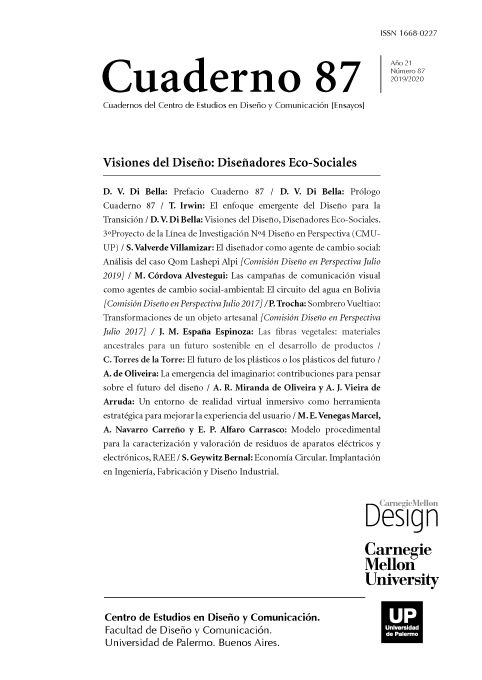El futuro de los plásticos o los plásticos del futuro
Abstract
In recent times, politicians, environmental activists, journalists and other opinion leaders have directed their weapons against plastics. This bad concept was born as a result of the changes in the environment as a result of the use of new sources of energy, both nuclear and fossil fuels and the development of the petrochemical industry, especially the plastics that occurs from the discovery of the oil. However, despite environmental considerations, plastic has built our world to the point where today it is difficult to imagine our life without it.
Many designers have argued since the mid-twentieth century, that good quality items can be beautiful and do not have to cost a lot of money. The couple of designers formed by Charles and Ray Eames proposed to provide people the best at the lowest possible price. They used in their designs aluminum, plywood, some other materials and mainly plastic. French designer Philipe Starck, agrees with his predecessors. He likes this material because of its democratic possibilities and because unlike natural materials it is a product of human intelligence, perfect for our human civilization. He argues that from an ecological perspec tive it is better to use plastic instead of wood. The Danish designer Verner Panton was not inspired by natural fibers or wood. He imagined organic forms and garish colors. He was attracted by the new materials that emerged after the Second World War, steel profiles, plywood and especially plastics. At the beginning of the sixties he already had a reputation for his playful designs. He furnished a hotel with inflatable plastic furniture, designed retro-lit plastic wall panels, UFO-shaped lamps and chairs with rolled metal cylinders and, thanks to plastic injection molding technology, created his famous one-piece chair.
With a more critical look, many plastic objects have been questioned by people in the same industry. One inexpensive evolution of the one-piece chair was the monoblock chair in which the minimum possible material is used. Rolf Fehlbaum, president of Vitra Design says that you can perceive the idea of low price implicit in the product, that the chair suggests a moral minimum: how to make them as cheap as possible so that they last a few years and then you can throw them away.
Then it is possible to ask if it is possible to protect the environment without dispensing with the advantages presented by plastics and their properties and that these are once again considered a solution to environmental problems as they were in 1936 when a woman said after visiting the exhibition The Wonderful World of Chemistry, “It’s wonderful how DuPont is improving nature.”
Since the entire plastics industry admits that this has to be more sustainable, the future of plastics and that of the industry depends on making them safer for people and for the planet.
There are a lot of attempts to obtain the so-called “green plastics”. This is the sector of the industry that grows the fastest, approximately 10% per year. There are those who are experimenting with renewable raw materials, returning the industry to its roots by using plant material as in the celluloid era.
If these proposals are successful maybe our future is not in the garbage truck and we can promote a greater use of non-polluting plastics that preserve the freedom to design that characterizes these materials redefining what a German critic called Plastikoptimismus.
References
Annicchiarico, S. (2012). La cultura del plástico. en Kartell the culture of plastics. Milán, Italia: Taschen.
Barrera, K.; Peponi, L.; Navarro, I.; Alpizar, A.; Marcos, A.; Kenny, J.; …Martínez, A. (2015). Polimerización enzimática para la síntesis de biopolímeros. Revista de plásticos modernos, 110 (703) 22-28.
Buranyi, S. (13 de noviembre de 2018). The plastic backlash: what’s behind our sudden rage – and will it make a difference? The Guardian. Recuperado de: https://www.theguardian.com/environment/2018/nov/13/the-plastic-backlash-whats-behind-our-sudden-rageand-will-it-make-a-difference
Camacho, M.; Vega, J. y Campos, A. (2011). Uso de nanomateriales en polímeros para la obtención de bioempaques en aplicaciones alimentarias. Revista de la Sociedad Química del Perú, 77(4), 292-306. Recuperado en 11 de diciembre de 2018, de http://www.scielo.org.pe/scielo.php?script=sci_arttext&pid=S1810-634X2011000400007&lng=es&tlng=es
Cruz, R.; Martínez, Y. y López, A. (2013). Biopolímeros y su integración con polímeros convencionales como alternativa de empaque de alimentos. Temas selectos de ingeniería de alimentos, (7-2), 42–52.
De la Cruz, S. (2018). Qué son los plásticos verdes o bioplasticos. Diario Ecología. Recuperado de: http://diarioecologia.com/que-son-los-plasticos-verdes-o-bioplasticos/
Eun, J.; Jae, S.; Jun, W.; Jun, H.; Kim, B.; Lee, H.; …Lee, S. (2018). One-step fermentative production of aromatic polyesters from glucose by metabolically engineered Escherichia coli strains. Nature Communications 9 (1). doi: 10.1038/s41467-017-02498-w
Equipo editorial de Tecnología del Plástico. (2011). Polímeros verdes de Braskem, buena química con el mercado. Tecnología del Plástico, (27), 23.
Equipo editorial de Tecnología del Plástico. (2012). Resinas y aditivos en NPE 2012. Tecnología del Plástico, (32), 26-27.
Freinkel, S. (2012). Plástico: un idilio tóxico. Barcelona, España: Tusquets.
Lopez - Portillo, J. (2018). La gran transición: retos y oportunidades del cambio tecnológico exponencial. México: Fondo de cultura económica.
Manahan, S. (2007). Introducción a la química ambiental. México: Reverté.
Ortega, M. (2011). ¿Se acerca el fin de la sostenibilidad como factor agregado? Tecnología del Plástico, (26), 4.
Parker, L. (2018). Plástico. National Geographic en español. 42 (6), 28-55.
Smith, R. y Lourie, B. (2009). Slow death by rubber duck: the secret danger of everyday things. Berkley, CA, USA: Counterpoint.
Wolf, O.; Crank, M.; Patel, M., Marscheider-Weidemann, F.; Schleich, J.; Hüsing, B. y Angerer, G. (2005). Tehno-Economic Feasibility of Large-Scale Production of Bio-Based Polymers in Europe. Fraunhofer ISI. Recuperado de: https://www.researchgate.net/publication/44262558_Tehno-Economic_Feasibility_of_Large-Scale_Production_of_BioBased_Polymers_in_Europe
Los autores/as que publiquen en esta revista ceden los derechos de autor y de publicación a "Cuadernos del Centro de Estudios de Diseño y Comunicación", Aceptando el registro de su trabajo bajo una licencia de atribución de Creative Commons, que permite a terceros utilizar lo publicado siempre que de el crédito pertinente a los autores y a esta revista.


